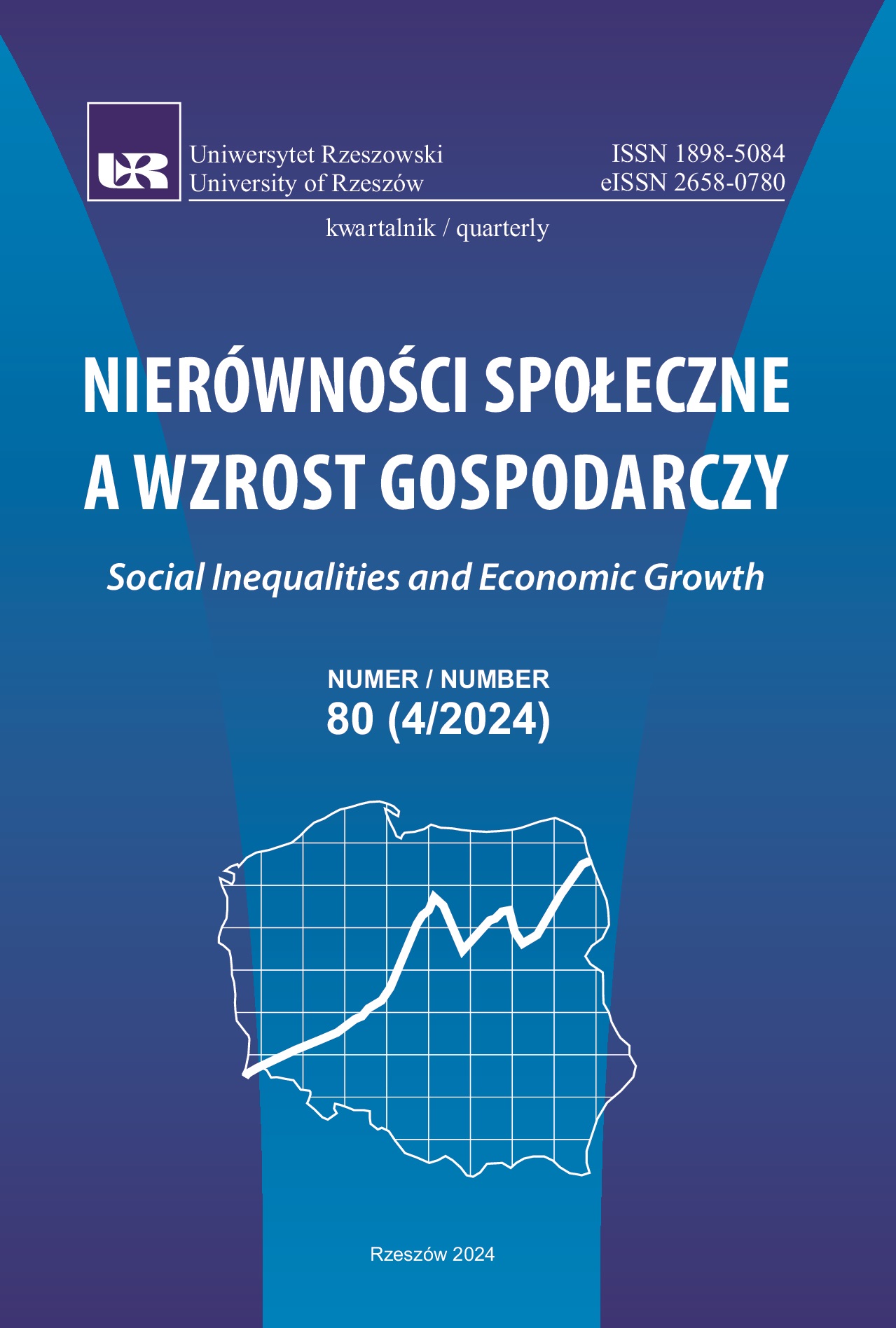Foreign direct investment in Sahel countries – an opportunity to reduce or a threat to deepen disparities in socio-economic development?
DOI:
https://doi.org/10.15584/nsawg.2024.4.3Keywords:
Sahel, FDI, socio-economic inequalityAbstract
The Sahel region is characterized by its strategic location and abundant natural resources. Despite its significant development potential, the Sahel region faces serious socio-economic problems. The article aims to present the scale of FDI flowing into the Sahel countries in relation to the distribution of these investments in the world, and selected characteristics of socio-economic development showing the situation in the region.
The article begins with a general presentation of the socio-economic and political situation of the Sahel region, a region of sub-Saharan Africa. After a brief consideration of the impact of foreign direct investment on the economies of the host countries, the scale of foreign direct investment made in the Sahel countries between 2000 and 2023 is presented against the background of the distribution of such investments in the world and in Africa. Using selected characteristics, the inequality of socioeconomic development in the area of sub-Saharan Africa was shown, demonstrating the differences between the Sahel countries and South Africa and Nigeria, i.e. the countries recording the injection of the highest value of capital, which in the form of FDI flowed into this part of the continent.
In light of the information and facts cited, an attempt was made to answer the question: whether, under current conditions, FDI is an opportunity to reduce social inequality or a threat to widen it. Unfortunately, contrary to the common perception of FDI as a factor contributing to socio-economic development, especially in countries experiencing equity shortages, the conclusions of the research presented in the article, as well as the information presented, may indicate that at present FDI does not bring an opportunity to reduce the disproportion of socio-economic development in the region and may pose a threat to its deepening.
Downloads
References
Adegboye, F., Okorie, U. (2023). Fragility of FDI flows in sub-Saharan Africa region: does the paradox persist? Future Business Journal, 9, 1–9. DOI: 10.1186/s43093- 023-00184-6.
Africa. Explore the regions. (2024). Pobrano z: https://www.thirteen.org/wnet/africa/ex-plore/sahel/sahel_overview_lo.html (2024.10.03).
Asamoaha, L.A., Mensaha, E.K., Bondzieb, E.A. (2019). Trade openness, FDI and economic growth in sub-Saharan Africa: do institutions matter? Transnational Corporations Review, 11(1), 67–79. DOI: 10.1080/19186444.2019.1578156.
Ayenew, B. (2022). The effect of foreign direct investment on the economic growth of Sub-Saharan African countries: An empirical approach. Cogent Economics & Finance, 10(1), 1–12. DOI: 10.1080/23322039.2022.2038862.
Bednarz, P. (2024). Jak chińskie pożyczki kolonizują Afrykę? Pobrane z: https://www.obserwatorfinansowy.pl/tematyka/makroekonomia/trendy-gospodarcze/jak-chinskie-pozyczki-kolonizuja-afryke/ (2024.10.12).
Buchalik, L. (2024). Stan bezpieczeństwa w krajach Sahelu w kontekście zamachów stanu. W: K. Czernichowski, J. Różański (red.), Afryka bogactwo możliwości i współpracy (s. 48–49). Pelplin: Bernardinum.
Dunning, J. (1992). The Competitive advantage of countries and the activities of transnational corporations. Transnational Corporations Review, 1(1), 150–151.
Institute for Economics & Peace. (2024). Global Terrorism Index. Pobrane z: https://www.economicsandpeace.org/reports/ (2024.10.12).
International Trade Administration. (2024). Senegal – Investment Climate Statement. Pobrane z: https//www.trade.gov/country-commercial-guides/senegal-investment-climate-statement (2024.09.03).
Jaworek, M., Karaszewski, W. (2020). Kapitał zagraniczny w przedsiębiorstwach prowadzących działalność na obszarze Polski od Królestwa Polskiego do końca II Rzeczypospolitej (s. 26–28). Toruń: Wydawnictwo Naukowe Uniwersytetu Mikołaja Kopernika.
Kania, M. (2019). Trudny region: Sahel w cieniu terroryzmu i konfliktów etnicznych. Analiza ZBN UJ, 7(46), 1–9.
Karaszewski, W., Wiśniewski, J. (2000). Bezpośrednie inwestycje zagraniczne w Polsce: ich skala, struktura i wpływ na procesy rozwojowe. Ekonomista, 4, 569–586.
Krugman, P., Wells, R. (2012). Makroekonomia. Warszawa: Wydawnictwo Naukowe PWN.
Kucharczyk, M. (2023). „The Washington Post”: Tutaj każdy dzień może być ostatnim. Wstąpienie do islamistów lepsze niż głód. Pobrane z: https://wydarzenia.interia.pl/raport-media-zagraniczne/news-the-washington-post-tutaj-kazdy-dzien-moze-byc-ostatnim-wsta,nId,6884034 (2024.10.02).
Jan Paweł II. (1985). Apel w sprawie Sahelu. W: Jan Paweł II w Afryce. Warszawa: Instytut Wydawniczy PAX, s. 255.
Lloyds Bank. (2024). Foreign direct investment (FDI) in Chad. Pobrane z: https://www.lloydsbanktrade.com/en/market-potential/chad/investment (2024.09.09).
Lloyds Bank. (2024). Burkina Faso: Investing. Pobrane z: https://www.lloydsbanktrade.com/en/market-potential/burkina-faso/investment (2024.09.09).
Lloyds Bank. (2024). Eritrea: Investing. Pobrane z: https://www.lloydsbanktrade.com/en/market-potential/eritrea/investing (2024.09.30).
Lloyds Bank. (2024). Mali: Investing. Pobrane z: https://www.lloydsbanktrade.com/en/market-potential/mali/investing (2024.09.15).
Lloyds Bank. (2024). Foreign direct investment (FDI) in Mauritania. Pobrane z: https://www.lloydsbanktrade.com/en/market-potential/mauritania/investment (2024.09.30).
Lloyds Bank. (2024). Niger: Investing. Pobrane z: https://www.lloydsbanktrade.com/en/market-potential/niger/investing (2024.09.05).
Ludność Afryki: Demografia. (2024). Pobrane z: https://www.populationof.net/africa/ (2024.10.11).
Marszałkowski, M. (2020). Rekordowe odkrycia węglowodorów na świecie. Pobrane z: https://biznesalert.pl/ropa-gaz-wydobycie-rekord-rystad-energy-energetyka (2024.09.10).
Mazur, J. (2024). Moskwa znalazła sposób na finansowanie wojny. Znajduje się w Afryce. Pobrane z: https://wydarzenia.interia.pl/raport-ukraina-rosja/news-moskwa-znalazla-sposob-na-finansowanie-wojny-znajduje-sie-w-,nId,7822453 (2024.10.05).
Obaji Jr., P. (2023). Sudan: Russia’s Wagner Group and the grab for power and gold. Pobrane z: https://www.dw.com/en/pmc-russias-wagner-group-in-sudan-gold-military-junta/a-65439746 (2024.10.01).
Olech, A., Wójtowicz, B. (2022). Rywalizacja o surowce w Sahelu – region konfliktu mocarstw. Kidderminster: Trójmorze, 10. Pobrane z: https://trimarium.pl/projekt/rywalizacja-o-surowce-w-sahelu-region-konfliktu-mocarstw/ (2024.10.05).
Parafianowicz, Z. (2022). Projekt Kontynent. Tak Afryka pomoże Rosji złagodzić skutki sankcji. Pobrane z: https://gospodarka.dziennik.pl/news/artykuly/8442292,projekt-kontynent-afryka-rosja-sankcje-wojna-ukraina.html (2024.10.05).
Patrzylas, A. (2024). Rosja przejmuje w Afryce nowe kopalnie złota. Kreml pozyskuje środki na wojnę z Ukrainą. Pobrane z: https://forsal.pl/swiat/artykuly/9618330,rosja-przejmuje-w-afryce-nowe-kopalnie-zlota-kreml-pozyskuje-srodki-n.html (2024.10.05).
Sakyi, D., Egyir, J. (2017). Effects of trade and FDI on economic growth in Africa: an empirical investigation. Transnational Corporations Review 9(2), 66–86. DOI: 10.1080/19186444.2017.1326717.
Transparency International. (2024). Corruption Perceptions Index. Pobrane z: https://www.transparency.org/en/press/media-advisory-transparency-international-corruption-perceptions-index-11-oktober-2024 (2024.10.11).
UNCTAD. (2024). World Investment Report 2024. Pobrane z: https://unctad.org/topic/ investment/world-investment-report (2024.10.31).
UNICEF. (2024). Narasta konflikt w środkowym Sahelu – 14 mln dzieci zagrożonych. Pobrano z: https://centrum-prasowe.unicef.pl/234535-narasta-konflikt-w-srodkowym-sahelu-14-mln-dzieci-zagrozonych (2024.10.11).
United Nations Development Program. (2024). Human Development Reports. https://hdr.undp.org/content/human-development-report-2023-24 (2024.12.11).
U.S. Departament of State. (2024). Investment Climate Statements: Sudan. Pobrane z: https://www.state.gov/reports/2022-investment-climate-statements/sudan/ (2024.09.09).
Wako, H.A. (2021). Foreign direct investment in sub-Saharan Africa: Beyond its growth effect, Research in Globalization, 3, 1–12. DOI: 10.1016/j.resglo.2021.100054.
Yabi, G.O. (2024). The Sahel’s Intertwined Challenges. Finance & Development September 2024: Productivity and How to Revive It, International Monetary Fund, 61(003), 56–57. DOI: 10.5089/9798400276231.022.
Downloads
Published
How to Cite
Issue
Section
License
Copyright (c) 2025 University of Rzeszow

This work is licensed under a Creative Commons Attribution-NonCommercial-NoDerivatives 4.0 International License.


